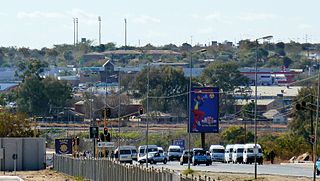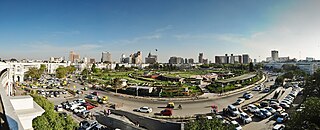
The tertiary sector of the economy, generally known as the service sector, is the third of the three economic sectors in the three-sector model. The others are the primary sector and the secondary sector (manufacturing).

The economy of Jamaica is heavily reliant on services, accounting for 70% of the country's GDP. Jamaica has natural resources and a climate conducive to agriculture and tourism. The discovery of bauxite in the 1940s and the subsequent establishment of the bauxite-alumina industry shifted Jamaica's economy from sugar, and bananas.

The economy of Mauritius is a mixed developing economy based on agriculture, exports, financial services, and tourism. Since the 1980s, the government of Mauritius has sought to diversify the country's economy beyond its dependence on just agriculture, particularly sugar production.

The Economy of Qatar is one of the highest in the world based on GDP per capita, ranking generally among the top ten richest countries on world rankings for 2015 and 2016 data compiled by the World Bank, the United Nations, and the International Monetary Fund (IMF). The country's economy has grown despite sanctions by its neighbors, Saudi Arabia and the United Arab Emirates. Mainly because the country exports primarily to Japan, South Korea, India and China, making the sanctions effectively redundant as neither Saudi Arabia nor the United Arab Emirates have imposed trading penalties such as tariffs or embargoes on either of these countries for trading with Qatar, or offering incentives such as discounts for their own energy exports to reduce Qatari exports.

Once a single-crop agricultural economy, Saint Lucia has shifted to a tourism and banking serviced-based economy. Tourism, the island's biggest industry and main source of jobs, income and foreign exchange, accounts for 65% of its GDP. Agriculture, which was once the biggest industry, now contributes to less than 3% of GDP, but still accounts for 20% of jobs. The banana industry is now on a decline due to strong competition from low-cost Latin American producers and reduced European trade preferences, but the government has helped revitalize the industry, with 13,734 tonnes exported in 2018. Agricultural crops grown for export are bananas, mangoes, and avocados. The island is considered to have the most diverse and well-developed manufacturing industry in the eastern Caribbean.

The economy of Trinidad and Tobago is the third wealthiest in the Caribbean and the fifth-richest by GDP (PPP) per capita in the Americas. Trinidad and Tobago is recognised as a high-income economy by the World Bank. Unlike most of the English-speaking Caribbean, the country's economy is primarily industrial, with an emphasis on petroleum and petrochemicals. The country's wealth is attributed to its large reserves and exploitation of oil and natural gas.

The economy of Saint Kitts and Nevis has traditionally depended on the growing and processing of sugar cane; decreasing world prices have hurt the industry in recent years. Tourism, export-oriented manufacturing, and offshore banking activity have assumed larger roles in Saint Kitts and Nevis. Most food is imported. The government has undertaken a program designed to revitalize the faltering sugar sector. It is also working to improve revenue collection in order to better fund social programs. In 1997, some leaders in Nevis were urging separation from Saint Kitts on the basis that Nevis was paying far more in taxes than it was receiving in government services, but the vote on cessation failed in August 1998. In late September 1998, Hurricane Georges caused approximately $445 million in damages and limited GDP growth for the year.

Gauteng is one of the nine provinces of South Africa.

Hammanskraal is a non-functional, trans-provincial region anchored in northern Gauteng Province, South Africa. The region consists of multiple, residential, industrial and commercial areas in a decentralized settlement pattern.

The Ministry of Economic Development, Job Creation and Trade in the Canadian province of Ontario is responsible for programs to attract and retain business and economic development in the province. This is pursued through research and development funding, business advisory services, career exploration opportunities and business startup programs for youth, skills development and marketing Ontario to potential international business investors.

The Sedibeng District Municipality is one of the districts of the Gauteng province of South Africa. The administrative seat of the district is Vereeniging. As of 2011, the most widely spoken language among its 794,605 inhabitants was Sesotho.
The Southern Education and Research Alliance (SERA), founded in 1999, is a strategic alliance formed between the University of Pretoria and the Council for Scientific and Industrial Research. The alliance collaborates locally and internationally with universities, NGO's, companies and multinational bodies in various research areas. Sera has a 50% shareholding in the Innovation Hub, a fully accredited technology park situated on 60 hectares of the university's experimental farm.

Southern Alberta is a region located in the Canadian province of Alberta. In 2016, the region's population was approximately 291,112. The primary cities are Lethbridge and Medicine Hat. The region is known mostly for agricultural production, but other sectors, such as alternative energy, film production and tourism, are emerging.

Midvaal Municipality is a local municipality within the Sedibeng District Municipality, in the Gauteng province of South Africa. The municipality's name references its geographical location in-between the Johannesburg and East Rand areas and the Vaal and Vereeniging areas.
The Space Innovation and Growth Team was a joint initiative among the United Kingdom government, academia and the country's space industry. Its goal was to define a 20-year vision and strategy for the future growth of the UK space industry, which was published in February 2010 as the Space Innovation and Growth Strategy (IGS).

The economy of the Western Cape in South Africa is dominated by the city of Cape Town, which accounted for 72% of the Western Cape's economic activity in 2016. The single largest contributor to the region's economy is the financial and business services sector, followed by manufacturing. Close to 30% of the gross regional product comes from foreign trade with agricultural products and wine dominating exports. High-tech industries, international call centres, fashion design, advertising and TV production are niche industries rapidly gaining in importance.

Telangana is one of the fastest-growing states in India posing average annual growth rate of 13.90% over the last five years. Telangana's nominal gross state domestic product for the year 2020-21 stands at ₹13.59 lakh crore. Service sector is the largest contributor to the Telangana's economy with a share of about 65% in the year 2018-19. Growth in services has largely been fuelled by IT services with the State holding leading position in IT & ITeS in the country in terms of production and exports.

Blue economy is a term in economics relating to the exploitation, preservation and regeneration of the marine environment. Its scope of interpretation varies among organizations. However, the term is generally used in the scope of international development when describing a sustainable development approach to coastal resources. This can include a wide range of economic sectors, from the more conventional fisheries, aquaculture, maritime transport, coastal, marine and maritime tourism, or other traditional uses, to more emergent activities such as coastal renewable energy, marine ecosystem services, seabed mining, and bioprospecting.

The economy of Delhi is the 13th largest among states and union territories of India. The Nominal GSDP of the NCR was estimated at 272.603 Billion and the Nominal GSDP of the NCT of Delhi for 2022-23 was estimated at ₹10.83 lakh crore (US$140 billion) recording an annual growth of 8.1%. Growth rate in 2014-15 was 9.2%. In 2020-21, the tertiary sector contributed 85% of Delhi's GSDP followed by the secondary and primary sectors at 12% and 3% respectively. The services sector recorded an annual growth of 7.3%. Delhi is the largest commercial centre in northern India. As of 2021, recent estimates of the economy of the urban area of Delhi have ranged from $370 billion and it has $272.603 billion as ranking it either the most or second-most productive metro area of India.

The Dinokeng Game Reserve is a wildlife sanctuary in the province of Gauteng, South Africa and can be accessed via the N1 route. It is a 40-minute drive from Pretoria or 75 minutes from the O. R. Tambo Airport and Johannesburg. The reserve has the Big Five game animals, and is open for visitors to explore. It covers an area of approximately 21,000 hectares. The name, Dinokeng, is derived from the language of the Tswana and Bapedi people, and is translated as “a place of rivers”.

















